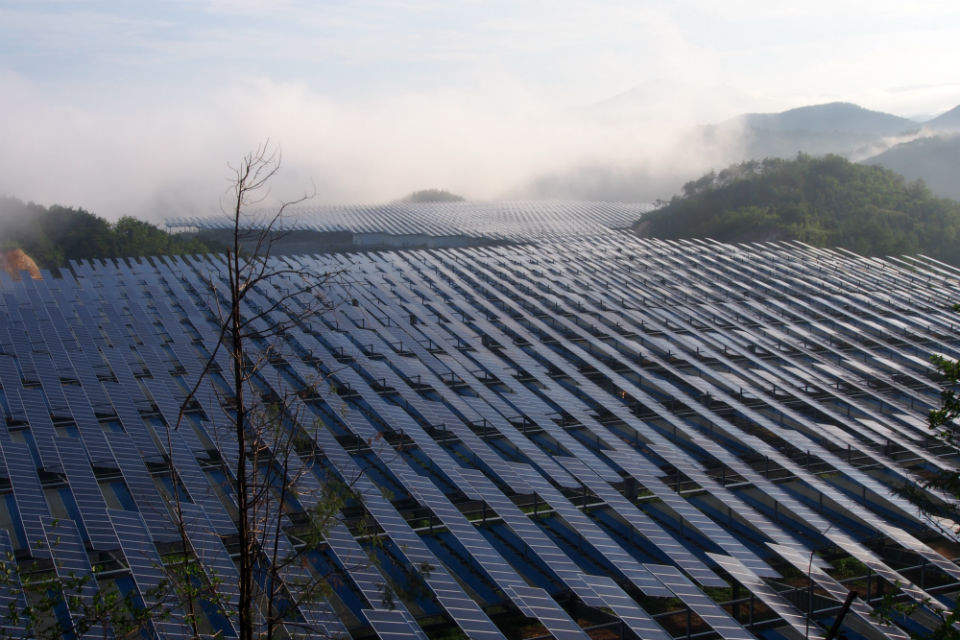
Beyond the Static: Renewable Energy in South Korea
As the sun rises over the mountains of Gangwon Province, the valleys are still full of mist. Cuckoos call and frogs cross the roads. Above the fields of maize and ginseng, another silent crop prepares to gorge itself on the intensifying sunlight. Soon, the thousands upon thousands of photovoltaic panels that make up Yeongwol Solar Power Plant will begin sending electricity to the national grid for another day.
Yeongwol is South Korea’s biggest solar power plant, generating 40MW of power. Yet this represents only a fraction – less than 0.0004% – of the country’s total generation capacity.
But now, President Moon Jae-in has pledged to increase renewable energy’s share of the electricity generation mix to 20% by 2030 – seemingly an ambitious target given that renewable sources generated just four percent of the country’s electricity in the first three months of 2017.

Meanwhile, South Korea’s nuclear energy fans are whipping up a frenzy of self-justification as the government attempts to abandon the construction of two new reactors. Part of this process involves dismissing renewable energy. The national English daily Korea Herald’s recent claim that “experts” believe “Korea does not have enough technological knowledge to increase its energy reliance on renewable sources,” is a typical refrain that could easily have been used in 1959, when the government first established the Office of Atomic Energy.
Beyond the disinformation and misunderstanding, how much renewable energy is available in South Korea’s land, seas and skies? How much of it can feasibly be captured? And what obstacles are stopping South Korea from becoming a giant in the global renewables industry, as it has in so many others?
Abundant potential
In short, there’s more than enough natural energy out there to power South Korea several times over. A 2016 government white paper put the total potential amount of electricity that could feasibly be produced from renewables using current technology (“technical potential”) at more than 12 million gigawatt hours per year (GWh/year). In 2016, a total of some 540,000 GWh was produced in South Korea from all sources combined: coal, nuclear and the rest. In other words, there is at least 20 times more renewable energy available than South Korea currently uses from all sources. The vast majority of this is solar, clocking in at a potential yield of more than 10 million GWh/year.
And these are just conservative figures: The technical potential of renewables will rise in the future as technology and efficiency improve, allowing more electricity to be made from the same amount of sunlight.
Given that South Korea currently imports some 94% of its energy sources, at a cost of nearly USD 81 billion in 2016, big savings could be made in the long term by switching to free and abundant renewables.

Current situation
As the low share of renewables in South Korea’s energy mix shows, the country is now only capturing a fraction of its available renewable resources.
South Korea reached an installed renewable capacity — the maximum power it can produce using renewables at any given moment — of 13GW last year. In order to meet Moon Jae-in’s target of 20% renewable share, which is not particularly high by global standards, the country would have to increase this to 57GW over the next 13 years, according to the Ministry of Trade, Industry and Energy (MOTIE). The ministry cited lack of land for installing solar and wind plants and local opposition as key obstacles to developing renewables, and decided to focus on improving regulations; overcoming hostility by getting members of the public involved in projects (e.g. as shareholders) and creating successful examples; getting public corporations and local authorities involved; and creating jobs and developing the industry.
Lack of space is certainly an issue. Much of South Korea’s terrain consists of wooded mountains that are considered unsuitable for installing solar or wind farms, while farmland accounts for a good part of the remainder. Tesla founder and renewable energy pioneer Elon Musk recently declared that all of the United States’ electricity demand could be met by just one giant solar farm covering a square 100 miles long on each side, but South Korea does not have the large expanses of desert or scrubland available for a similar megaproject.
But solar plants are appearing, sometimes through novel use of space. Korea Rural Community Corporation (KRC) will have three new floating solar farms built by 2019, two with capacities of 100MW and one with 80MW, on lakes — by comparison, the floating solar farm that went online in Huainan, China to much fanfare earlier this year has a capacity of 40MW.
Jo Kang-hun of KRC’s energy development department told Korea Exposé that the corporation had been looking for ways to make use of the reservoirs and lakes that it manages nationwide, and hit upon the idea of solar energy. “We plan to build more plants in the future,” he said. “The three farms to be built by 2019 are the biggest in the world so far. We’ll put some of the profit back into local development projects.”
Some have made more radical suggestions. Gacheon University professor Hong Jun-hui argued in June that using 10% of all the agricultural land now under cultivation in South Korea would generate 129,000 GWh/year – the same as the country’s entire nuclear industry. Critics expressed outrage at the notion of using farmland for non-farming purposes, given South Korea’s low food self-sufficiency rate (50.2% in the 2014-2015 grain year, the most recent available statistic), but Hong responded, “All agriculture is about using fields to harness energy from the sun — whether in the form of carbohydrates via photosynthesis in plant crops or by using photovoltaic panels to generate electricity.” Some solar panel configurations also allow conventional crops to still be grown beneath.
Whether Hong’s “agri-PV” vision will become a reality is unclear, but solar does now appear to be taking off in South Korea, albeit from a small base. In 2016, the country’s photovoltaic solar capacity increased by more than 25%, from 3.5GW to 4.4GW — the seventh biggest increase of any country worldwide. In the first half of 2017, more than 0.5GW was installed, putting the country on course for as much as 1.2GW in new solar capacity this year given that installations from July to December are generally 20% greater than in January to June.
Wind power lags behind solar, but installed capacity passed 1GW in South Korea for the first time in 2016. In the same year, the country saw its first offshore wind plants – offshore wind generally benefits from higher wind speeds and less local opposition.
Energy storage systems (ESS) are an essential companion to renewable energy generation. The sun doesn’t shine at night, and the wind blows intermittently, so facilities are needed to store electricity, like a giant battery, for use at time when it’s not being generated. South Korea’s ESS capacity grew by 0.2GW in 2016 and the country now has the world’s second biggest stationary grid-connected battery storage capacity, after the U.S. Grid connected stationary batteries are an essential part of power grids that use renewable generation sources, though the development of more smart technology (systems that can coordinate the distribution of power between generators, users and batteries) will help create more storage options in future. The batteries of electric vehicles, for example, could be used as a source of grid power when the vehicles were plugged into the grid and not being driven.
Storage aside, the small increases in renewable energy generation capacity until now will not be enough to get South Korea to Moon Jae-in’s target of a 20% renewable share by 2030. According to MOTIE, an average of 1.7GW in renewable capacity is now being added in South Korea each year, but this will have to be increased by 2GW to 3.7GW per year in order to reach the aforementioned 57GW figure by 2030, with 80% of this generated by sun and wind. It’s a tall order.

The obstacles
The problems of lack of space, local opposition and reluctance on the part of local authorities to issue permits are often cited as the main obstacles in the way of renewable energy.
This could change once more successful renewable plants are established. “Studies have shown that local opposition to wind farms decreases once they have been built,” said Lee Sang-hoon, director of the Green Energy Strategy Institute.
But Yu Jae-geun, chairman of Yeongwol Prosperity Association, claims that the large plant in Gangwon-do has brought almost no benefits to the local community, creating “zero” jobs. “Before they built the plant, they said it would draw tourists, but nobody’s coming to see it,” he said. “They need to do more to promote it.” Yu also reported that some farmers had claimed the plant raised the local temperature, adversely affecting the farms around it.
Meanwhile, behind the scenes, it appears that some of the energy industry’s big players are fighting to preserve their lead. The nuclear industry, in particular, is keen to maintain the huge momentum it gathered during the consecutive presidencies of Lee Myung-bak and Park Geun-hye. South Korea’s nuclear power industry saw its total sales increase by some 60% over the five years of Lee’s presidency, between 2007 and 2012, while Park Geun-hye’s government planned to build no less than 16 new reactors at a time when the country already had enough electricity.
Korea Hydro & Nuclear Power (KHNP), operator of all South Korea’s nuclear plants, spends large amounts of money on advertising in various local and national media, resulting in largely positive coverage of the nuclear industry. In the resulting discourse, renewables are generally treated as desirable but not enough to power the country, making nuclear the cheapest, safest, environmentally friendly (in that it creates no greenhouse gas emissions) and viable option.
South Korea’s mainstream media frequently argue that the country cannot sustain its successful nuclear power plant export industry if it country shuts down its own domestic plants. But this claim detracts attention from the rapid growth of renewables worldwide and the huge potential for South Korea to export renewable-related products.
Indeed, the country’s private sector is already capitalizing on these export opportunities. Samsung SDI, for example, is now the number one supplier of batteries to ESS facilities in North America, while Hanwha Q CELLS was the fourth biggest supplier of photovoltaic (solar) modules in the world in 2016. Several Korean companies also produce wind turbines, including Doosan Heavy Industries & Construction, which supplied the ten 3MW units in the country’s first offshore wind farm off the coast of Jeju Island in September 2016.
If South Korea’s renewable energy industry were now to enjoy the same level of government support for its exports as the country’s nuclear industry did under previous administrations, it may have even greater success overseas. Potential nuclear customers like Saudi Arabia certainly have enough sunlight, space and cash to build some formidable solar plants instead.
Time to aim higher
Jeju’s local government has announced a goal of powering the island entirely by renewable electricity by 2030. Not having a dense population or being home to heavy industry (which uses about 60% of all South Korea’s electricity) put the island at a relative advantage, but it will still need to go on an epic building spree, especially of offshore wind turbines, to reach this goal.
Modern South Korea has never shied away from ambitious targets and rapid development. Despite the obstacles, so many of the odds are in its favor: high technological sophistication, abundant manufacturing experience, a mushrooming export market for renewable technology and a population fed up of the fine dust pollution caused in part by fossil fuel-fired power plants, to name a few.
It now remains to be seen whether Moon Jae-in and his government can persuade South Korea’s power generators and consumers to exploit the free, clean natural energy that exists all around them in such abundance.
Cover image: Yeongwol Solar Power Plant (Ben Jackson/Korea Exposé)

